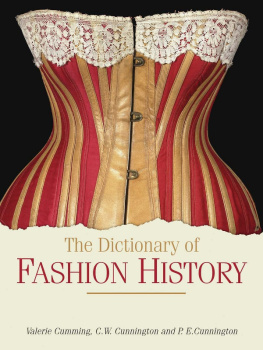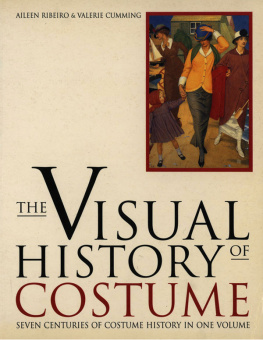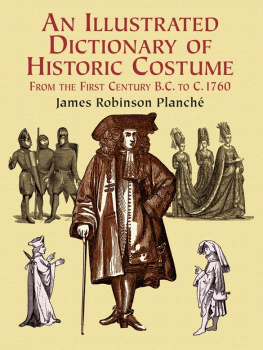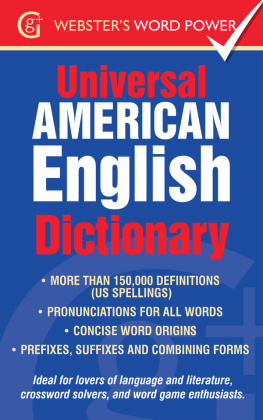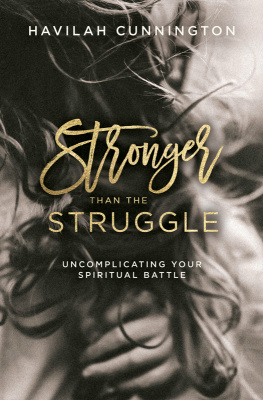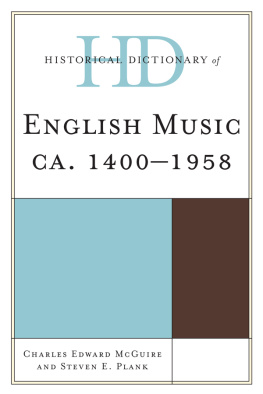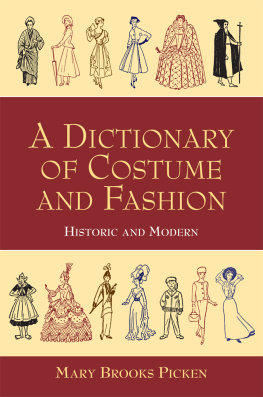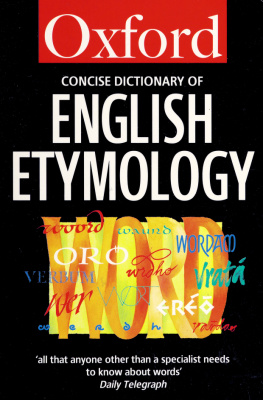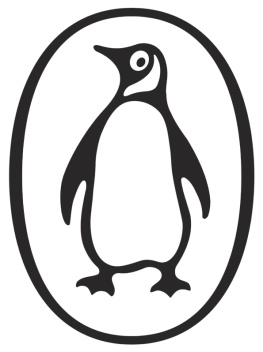Cumming Valerie - The Dictionary of Fashion History
Here you can read online Cumming Valerie - The Dictionary of Fashion History full text of the book (entire story) in english for free. Download pdf and epub, get meaning, cover and reviews about this ebook. City: London, year: 2017;2010, publisher: Berg Publishers;Bloomsbury Academic, genre: Home and family. Description of the work, (preface) as well as reviews are available. Best literature library LitArk.com created for fans of good reading and offers a wide selection of genres:
Romance novel
Science fiction
Adventure
Detective
Science
History
Home and family
Prose
Art
Politics
Computer
Non-fiction
Religion
Business
Children
Humor
Choose a favorite category and find really read worthwhile books. Enjoy immersion in the world of imagination, feel the emotions of the characters or learn something new for yourself, make an fascinating discovery.
- Book:The Dictionary of Fashion History
- Author:
- Publisher:Berg Publishers;Bloomsbury Academic
- Genre:
- Year:2017;2010
- City:London
- Rating:4 / 5
- Favourites:Add to favourites
- Your mark:
- 80
- 1
- 2
- 3
- 4
- 5
The Dictionary of Fashion History: summary, description and annotation
We offer to read an annotation, description, summary or preface (depends on what the author of the book "The Dictionary of Fashion History" wrote himself). If you haven't found the necessary information about the book — write in the comments, we will try to find it.
- What is an earthquake gown?- Who wore eelskin masher trousers? - What did the word dudes mean in the 16th century? A Dictionary of English Costume by C. Willett Cunnington, Phillis Cunnington and Charles Beard was originally published in 1960. A monum
The Dictionary of Fashion History — read online for free the complete book (whole text) full work
Below is the text of the book, divided by pages. System saving the place of the last page read, allows you to conveniently read the book "The Dictionary of Fashion History" online for free, without having to search again every time where you left off. Put a bookmark, and you can go to the page where you finished reading at any time.
Font size:
Interval:
Bookmark:
THE DICTIONARY OF FASHION HISTORY
THE
DICTIONARY OF FASHION
HISTORY
Valerie Cumming, C. W. Cunnington and
P. E. Cunnington
Based on A Dictionary of English Costume 9001900
by C. W. and P. E. Cunnington and Charles Beard,
now completely revised, updated and supplemented
to the present day by Valerie Cumming

This edition first published in 2010 by
Berg
Editorial offices:
First Floor, Angel Court, 81 St Clements Street, Oxford OX4 1AW, UK
175 Fifth Avenue, New York, NY 10010, USA
All materials not appearing in A Dictonary of English Costume 9001900 Berg
A Dictionary of English Costume 9001900 first published 1960
Reprinted 1965, 1968 and 1972
Reprinted 1976 with Glossary of Laces
by A&C Black
1960 C. Willett Cunnington and Phillis Cunnington
All rights reserved.
No part of this publication may be reproduced in any form
or by any means without the written permission of
Berg.
Berg is the imprint of Oxford International Publishers Ltd.
Library of Congress Cataloging-in-Publication Data
A catalogue record for this book is available from the Library of Congress.
British Library Cataloguing-in-Publication Data
A catalogue record for this book is available from the British Library.
eISBN: 978-1-8478-8738-2
Typeset by JS Typesetting Ltd, Porthcawl, Mid Glamorgan
Printed in the UK by the MPG Books Group
www.bergpublishers.com
CONTENTS
We are ill informed even of the names of the articles we wear. People come to years of discretion scarce know the difference between a plain Hat and a Lunardi; and I have heard a lady, who I was told had a very good education, mistake a Parachute for a Fitzherbert.
1786. The Lounger no. 76
History is a gallery of pictures in which there are few originals and many copies.
The Old Regime and the Revolution, Alexis de Tocqueville, 1856
I would never have contemplated lexicography, even in an area with which I am familiar, without the encouragement of Kathryn Earle at Berg. She has left me to do the work of revision and addition without interference and has regularly provided useful texts for me to dip into or reject. The Cunningtons are totemic figures in fashion history and I am pleased and somewhat alarmed to have my name linked with theirs; and for that I offer my thanks to their daughter Susan Luckham and the literary estate who administer their considerable oeuvre for agreeing to this revised and updated version of the dictionary.
Over the past three years, my involvement with volume 8 of the Berg Encyclopedia of WorldDress and Fashion provided useful evidence about how and why the words about costume, dress and fashion need careful thought because of the many different cultural and practical traditions from which they spring. Obviously, the bane of all lexicographers is that there are constant shifts in usage, new research within discrete areas, and the problem of what to include and what to leave out. Whenever I felt overwhelmed by the scale of the revision and update, I found the Cunningtons original approach inordinately helpful. Colleagues within the Costume Society and CHODA, former students and email correspondents have patiently answered questions about arcane fabrics or unlikely usage; I am grateful for their ideas but any errors are mine.
Finding appropriate illustrations was not easy but again I found help among colleagues and friends with private collections. As always, John Cumming has been generous with his expertise and good humoured as the dictionary invaded every aspect of our lives. Last, but by no means least, I owe a huge debt of gratitude to the staff at Chertsey Museum, especially Grace Evans, Keeper of Costume, for her help with selecting strong and multi-applicable images from the outstanding Olive Matthews Collection curated and displayed at that museum.
Picture credits
I am indebted to the following individuals and organizations for the use of their images:
National Portrait Gallery
Olive Matthews Collection, Chertsey Museum
Private collections
Victoria & Albert Museum
This revised and updated edition of what was once known as A Dictionary of English Costume9001900 builds on a successful formula which encompassed four reprints and minor revisions between 1960 and 1976. C. Willett Cunnington (18791961) and his wife Phillis (18871974) separately, together and in partnership with other authors dominated the discipline of costume history in Great Britain for several decades from the 1930s. Key texts from their publishing history are listed in the Bibliography for this book.
Although they were familiar with the work of earlier dress historians, notably J. R. Planch (17961880) whose encyclopedic approach had inspired Charles Beard, their innate curiosity and collecting instincts ensured that they re-examined sources and redefined the role of costume history, as it was then known. Their dictionary was an important addition to their output, in terms of both the summation and the distillation of their long commitment to the discipline. Today we use different words to describe the study of human apparel clothing, dress and fashion; costume is often perceived as being descriptive of theatrical disguise but terminology in this discipline is fluid and full of surprises.
The Cunningtons dictionary covered the period starting from 900 and ending at 1900. However, they certainly went beyond 1900 in their research and information gathering, thereby leaving a legacy of information which has informed this revised dictionary, alongside much more recent work into many aspects of post-1900 clothing, fashionable or otherwise. A major difference between the pre-1900 period and the succeeding 110 years is that fashion becomes increasingly associated with fame; couturiers, their internationally known clients, film stars and that awkward group that we define as celebrities redefine the construction of personal appearance. This revised dictionary includes a limited number of these but only when strictly necessary; there are other sources through which they can be tracked and which are specifically devoted to them.
Since the 1980s, several dictionaries have been published in Europe and North America, complementing rather than challenging the dictionary of Cunnington and Beard. They include earlier information, such as on Greek and Roman dress; offer a wider and more inclusive world view of clothing terminology; consider post-1900 developments in dress and fashion; or describe themselves as dictionaries when they are companions or directories offering descriptions of processes, and biographies of designers, producers and purveyors of fashion. There are infinitely more sources of information about this subject than when the Cunningtons were writing books and students of this discipline will either own or be able to find these in libraries or, increasingly, online. Also, there are academic projects operating within the dictionary tradition, such as The Lexis of Cloth and Clothing Project c. 7001450 led by Professor Gale Owen-Crocker, which is producing an analytical corpus of medieval dress and textiles terminology of the British Isles in the form of a searchable database innovatively illustrated. This will be a rich resource for early period specialists when it is available.
The intention of this revised edition of the dictionary is to continue the best elements of the CunningtonBeard volume, such as its cautious use of cross-referencing. Drainpipe trousers will appear under the appropriate alphabetical letter D and not under T for trousers. Also, where in English and American-English there are different meanings, these will be noted under the appropriate letter; for instance, the fact that trousers in American are called pants, whereas in English pants usually means an item of underwear. Ignoring these differences perpetuates the notion that one is correct and the other can be ignored; both are correct but in different parts of the world. It will be obvious to readers that American usage becomes increasingly important to fashion in the twentieth century, though possibly not as overarchingly influential as the many terms from European languages, especially French in earlier centuries.
Next pageFont size:
Interval:
Bookmark:
Similar books «The Dictionary of Fashion History»
Look at similar books to The Dictionary of Fashion History. We have selected literature similar in name and meaning in the hope of providing readers with more options to find new, interesting, not yet read works.
Discussion, reviews of the book The Dictionary of Fashion History and just readers' own opinions. Leave your comments, write what you think about the work, its meaning or the main characters. Specify what exactly you liked and what you didn't like, and why you think so.

